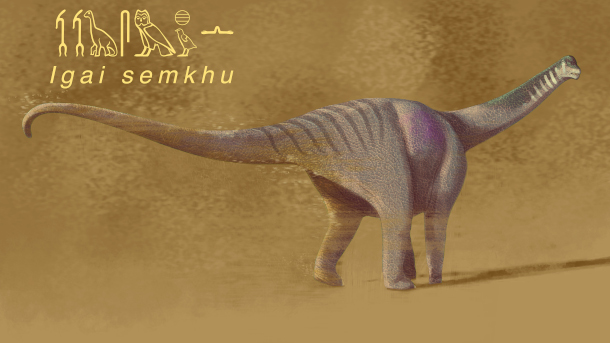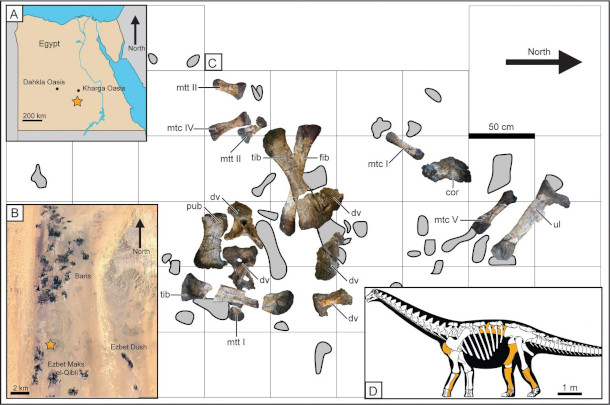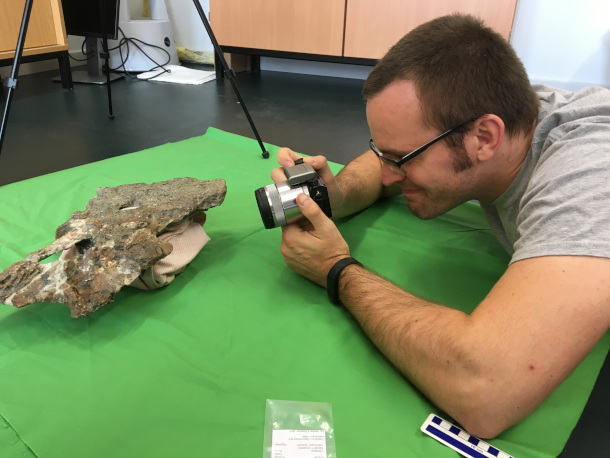A New Dinosaur
Air Date: Week of November 10, 2023

Igai semkhu was an herbivore. Its name translates to “forgotten lord of the oasis” in ancient Egyptian. (Image Credit for this Artist’s Rendering: Andrew McAfee & Talia Mastalski)
A dinosaur fossil discovered in Egypt in the 70s gathered dust in museums for decades and now it finally has a name as a new species, Igai semkhu. Paleontologist Dr. Eric Gorscak spoke with Host Aynsley O’Neill about why fossils from the end of the Age of Dinosaurs about 75 million years ago are relatively rare in Africa and what this “titanosaur” specimen can reveal about the distant past.
Transcript
O’NEILL: Paleontologists have discovered a new dinosaur, but the discovery has been almost fifty years in the making.In 1977, German geologists dug up a dinosaur fossil in Egypt’s Kharga Oasis. Over time, parts of that fossil went missing, and the specimen itself went largely forgotten apart from a master’s thesis written in the 90s.Decades more went by until an American scientist came across that paper and decided to delve a little deeper.And finally, in 2023, American, German, and Egyptian paleontologists came together to identify, describe, and name a new species of dinosaur, Igai semkhu.From some leg bones and a few vertebrae, scientists learned that igai semkhu was a long-neck dinosaur from a group known as “titanosaurs”.
The scientists involved in the discovery say it sheds new light on Africa’s dinosaurs during the Late Cretaceous, a period which has previously been somewhat of a mystery for paleontologists on the continent. I spoke with the lead author of the 2023 paper that officially named Igai semkhu a new dinosaur. Dr.Eric Gorscak is an Assistant Professor at Midwestern University and he told me that complicated discoveries like these aren’t uncommon in the paleontology world.
GORSCAK: You know, when we think about new dinosaurs, these new scientific discoveries, there's usually two stories. There's the scientific story, like the importance of that discovery in terms of our scientific understanding. And then there's also the human story that the tracking of discovery and how this fossil came to be and the people behind it. I always like to think of those two stories as intertwined with one another.
O'NEILL: Well, let's talk a little bit about what we can gather about the dinosaur itself. So what did Igai look like and what did it eat? How much of that are you able to figure out?

Dr. Gorscak studies one of the Igai semkhu fossils. Only a few fossils have ever been found, and some of those have gone missing over the decades. (Photo: Courtesy of Dr. Eric Gorscak)
GORSCAK: Yeah, that's a great question. It's challenging because the specimen itself, and this is true for paleontology, especially dinosaur paleontology, or any kind of vertebrate paleontology, is that it's rare to find complete skeletons. It is not the opening scene in Jurassic Park 99.9% of the time. So the specimen is really about like 12 bones from the middle part of the animals. We have a couple bones from the shoulder and arm, the backbones, a little bit of the hips and hind limbs, so we're missing a lot of the neck, the head, and the tail of this animal. But we are able to find certain traits or characteristics of these bones to understand what group of dinosaur it belongs to. And from there, we can compare it to more complete specimens to understand what it looked like. And Sauropods typically have a very general body plan, long necks, small head at the very end, large bodies, super long tail, kind of like Brontosaurus and Brachiosaurus. So it belongs to that group of dinosaurs. Now it wasn't that big of a dinosaur in terms of Titanosaurs relatively. One thing about titanosaurs is that they also included some of the largest land animals who have ever lived. So there's a reason why "titan" is in the name Titanosaur. But also the other cool thing about this group is that it also includes some of the smallest sauropod dinosaurs, something about maybe the size of a horse, which still pretty big, but for this group, kind of small. So I like to say you have titanosaurs and then you have "titiny-saurs" in this group. And everything in between, which is actually pretty wild. It's a really awesome group of dinosaurs. Quite the range, right? But Igai is somewhere in the middle, kind of what we call a medium sized titanosaur, but still a big animal, probably about like 30 to 45 feet in length for a Sauropod, which is actually kind of cool because there's another dinosaur from the same age rocks and areas that our team and Egyptian colleagues worked on a couple of years ago called Mansourasaurus, which is roughly the same size as Igai. But the difference is Igai has a little bit more slender limb bones than Mansourasaurus. Mansourasaurus is a little bit stockier, a little bit more stout in its appearance. So at least we have the two different kinds of Sauropods, smaller end within Late Cretaceous of Egypt, which is kind of cool. And definitely plant eaters, so don't be afraid to pet it if it was alive.
O'NEILL: Well, depending on the size, I might still be afraid of getting stomped on, you know?
GORSCAK: Yeah, there's that to just be gentle. no sudden movements.

Parts of Igai semkhu’s skeleton were found near the Kharga Oasis back in the 1970’s. Only now have scientists gotten the chance to study and name the species. (Credit: Courtesy of Dr. Eric Gorscak et al.)
O'NEILL: Okay. Well, so, when I think of dinosaurs, I think Brachiosaurus, Brontosaurus, Tyrannosaurus, maybe you get Iguanodon in there. But none of those names quite sounded like Igai semkhu. Where did your team come up with the name for that? And what does it mean?
GORSCAK: There's like over 1000 species of dinosaurs, but of course with like Tyrannosaurus, Brontosaurus, all the ones you just named, they've been around is more or less the very beginning of paleontology, when dinosaur paleontology really got hot. So they were the stars. They got that premacy for being described first and capturing the public attention and just living on, but we have so many new dinosaur species being discovered, especially in the past 20 years. But Igai semkhu is uh actually ancient Egyptian. And this is great because Dr. Lammanna, co author, works at the Carnegie Museum, and they have an Egypt department that he knows the people of. We got in contact with them. And we were just kind of spitballing ideas of just like the name of this dinosaur. We want to honor kind of the area where it came from and just Egypt and its rich history. And so with Lisa Haney, the Egypt department at the Carnegie, she kind of spitballed some like ancient deities, some ancient gods and like lore from the area of the Western desert where the specimen came from. So it was an ancient deity that this cult in the western desert worshipped. So basically translates to the Lord of the Oasis, and Titanosaurs are generally large animals. So just kind of seem fitting that the Lord of the Oasis was for this a giant Sauropod. And then Semkhu means forgotten from ancient Egyptian. So this is the Forgotten Lord of the oasis. Now I kind of like the name because it kind of alludes to the story of the specimen that was discovered in the 70s changed spots in different universities through time, people working on it and coming and going. So just kind of became this kind of like forgotten specimen, but also just kind of goes into the science story to where we have ancient Egypt and ancient Africa during the time of the dinosaurs. We don't know much about the fossil record compared to other landmasses — South American North America really good fossil records Europe and Asia as well. Africa seems to have this kind of... we don't have a full understanding of what was happening during the Age of Dinosaurs. So in a way it kind of alludes to that as well. This forgotten Lord of the Oasis, this forgotten dinosaur.

The co-author of the paper regarding Igai semkhu works out of the Carnegie Museum of Natural History. The Carnegie, and museums like it around the world, store thousands of specimens for decades so that scientist can study them with newer technologies. (Photo: Wally Gobetz, Flickr, BY-NC-ND 2.0)
O'NEILL: What's going on there that means that Africa's fossil record isn't as well known as the other continents?
GORSCAK: That's a good question. And it's not to say like it has a bad fossil record. It all depends on your question and the age of the deposits of these rocks. Unfortunately, for like the Cretaceous of Africa, it's a bit more spottier than other continents, but part of that is that a lot of the continent is covered in grasslands, rain forests, and vegetation, that access to those rocks is hard to get to. When you think about like out west in the desert, you have a lot of erosion happening like here in the United States, to expose all that rock. And you don't have too much of that when you go south of the Sahara. And with the Sahara, you have a lot of exposed rock, but also a lot of sand in the way. But those age rocks and those kind of depositional environments are not the ones conducive for what's happening on like the terrestrial land, like for land animals that were interested with dinosaurs. So really awesome marine deposits, but not so much land deposits. So it's already spotty as is with the exposed rock in these kind of questions and kind of dinosaurs that we're interested in, especially at the very end of the Cretaceous period, that last act of the age of dinosaurs. The story is being told, but the geological writings are not preserved or never had the chance to preserve because of these ancient environments. So it's always been a challenge. But thankfully, we're able to find some stuff. And we're getting a better picture in the recent couple of decades.
O'NEILL: What is this dinosaur able to tell you about ancient Africa, Ancient Egypt, sort of the Paleo history of this?

Dr. Gorscak photographs a vertebra from Igai semkhu. (Photo: Dr. Matthew Lamanna)
GORSCAK: The Cretaceous, like I said, this last act of the age of dinosaurs, we have a pretty good fossil record in North America, South America, Europe and Asia, most definitely. And by the end of the Cretaceous, Madagascar and India, we have all this, kind of a good idea of what's happening on these continents at the very end. But Africa is still kind of this question mark. And the cool thing with Igai, and Mansourasaurus I mentioned earlier, is that there's filling in this gap towards the very end of the Age of Dinosaurs for Africa. And so what we can see with the relationships based on the anatomy that is shared with Mansourasaurus and Igai with surrounding landmasses and their Titanosaurs, is that we see that Igai, Mansourasaurus, has features that are closely related to those from Europe and Asia, more so than those from like Southern Africa or even Gondwana with like South America and Madagascar. So we're getting an idea of how these faunas are, who the members are, what they're related to, and what they can tell us with that evolutionary history. There's still a lot more work to go. But this is really an exciting, like peek into that time period that we only can speculate it before. But now we had the fossils actually show that this was the case. I'm really excited to see how that develops. And of course, inspiring a new generation of paleontologist all over the world when they see like, yeah, there's dinosaurs everywhere. And there's natural wonder everywhere and trying to get that international collaboration going and inspiration.
O'NEILL: Dr. Eric Gorscak is assistant professor at Midwestern University. Dr. Gorscak, thank you so much for taking the time with us today.
GORSCAK: Of course, thank you so much for having me.
O'NEILL: For more on this dino, including specs for you to make your own 3d printed model, stomp on over to our website, loe.org.
Links
Read the full study and download the 3D models
Living on Earth wants to hear from you!
Living on Earth
62 Calef Highway, Suite 212
Lee, NH 03861
Telephone: 617-287-4121
E-mail: comments@loe.org
Newsletter [Click here]
Donate to Living on Earth!
Living on Earth is an independent media program and relies entirely on contributions from listeners and institutions supporting public service. Please donate now to preserve an independent environmental voice.
NewsletterLiving on Earth offers a weekly delivery of the show's rundown to your mailbox. Sign up for our newsletter today!
 Sailors For The Sea: Be the change you want to sea.
Sailors For The Sea: Be the change you want to sea.
 The Grantham Foundation for the Protection of the Environment: Committed to protecting and improving the health of the global environment.
The Grantham Foundation for the Protection of the Environment: Committed to protecting and improving the health of the global environment.
 Contribute to Living on Earth and receive, as our gift to you, an archival print of one of Mark Seth Lender's extraordinary wildlife photographs. Follow the link to see Mark's current collection of photographs.
Contribute to Living on Earth and receive, as our gift to you, an archival print of one of Mark Seth Lender's extraordinary wildlife photographs. Follow the link to see Mark's current collection of photographs.
 Buy a signed copy of Mark Seth Lender's book Smeagull the Seagull & support Living on Earth
Buy a signed copy of Mark Seth Lender's book Smeagull the Seagull & support Living on Earth

